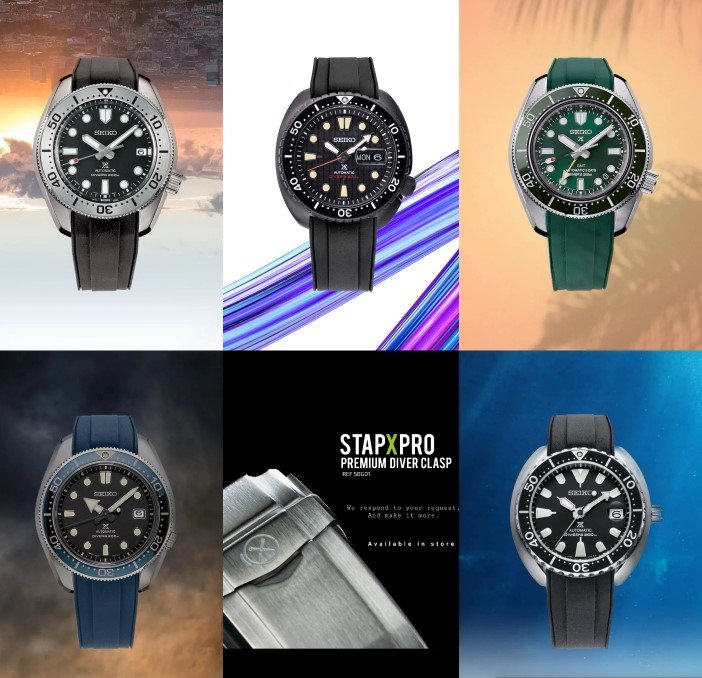The Seiko Speedtimer is a name that resonates deeply with watch enthusiasts, embodying a legacy of precision, innovation, and timeless design. Since its inception in the 1960s, the Seiko Speedtimer has carved a unique niche in the world of horology, blending cutting-edge technology with a sporty aesthetic that appeals to both collectors and casual wearers. This article explores the rich history of the Seiko Speedtimer, its technological milestones, and its enduring appeal in the modern watchmaking landscape.
Origins of the Seiko Speedtimer
The story of the Seiko Speedtimer begins in 1964, when Seiko served as the official timekeeper for the Tokyo Olympics. This pivotal moment in the brand’s history showcased its ability to produce highly accurate timekeeping instruments, setting the stage for the introduction of the Seiko Speedtimer in 1969. The original Seiko Speedtimer, notably the 1969 model equipped with the Caliber 6139, was a groundbreaking achievement. It was the world’s first automatic chronograph with a vertical clutch and column wheel, a mechanism that ensured precise timekeeping and smooth operation of the chronograph functions. This innovation placed Seiko ahead of many Swiss competitors, cementing its reputation as a pioneer in watchmaking.
The Seiko Speedtimer was designed with functionality in mind, catering to athletes, racers, and professionals who needed reliable timing instruments. Its name, “Speedtimer,” reflected its purpose: to measure time with speed and accuracy. The early models featured bold designs with tachymeter scales, allowing users to calculate speed based on travel time or distance, a feature that became synonymous with the series.
Evolution Through the Decades
Throughout the 1970s and 1980s, the Seiko Speedtimer evolved, incorporating new technologies and design elements. One iconic model from this era is the Seiko Speedtimer 6139 “Pogue,” named after Colonel William Pogue, who wore it during NASA’s Skylab missions. The “Pogue” Speedtimer, with its vibrant yellow dial and robust automatic movement, became a cult favorite among collectors. Its association with space exploration added a layer of prestige, making it one of the most sought-after vintage Seiko Speedtimers today.
In the 1980s, Seiko introduced quartz-powered Speedtimers, aligning with the brand’s pioneering work in quartz technology. These models, such as the 7A28 series, offered unparalleled accuracy and affordability, broadening the appeal of the Seiko Speedtimer to a wider audience. The quartz Speedtimers maintained the sporty aesthetic of their mechanical predecessors while introducing features like 1/10-second chronograph capabilities.
The Modern Seiko Speedtimer: Prospex Revival
In 2021, Seiko revived the Speedtimer name under its Prospex collection, a series dedicated to professional-grade sports watches. The modern Seiko Speedtimer models pay homage to their vintage counterparts while incorporating contemporary technology. For instance, the Seiko Prospex Speedtimer Solar Chronograph (SSC813) features a solar-powered V192 movement, offering eco-friendly functionality and six months of power reserve when fully charged. Its 39mm case size and “panda” dial—a black-and-white design reminiscent of vintage chronographs—have made it a favorite among enthusiasts for its versatility and retro charm.
The modern Seiko Speedtimer lineup also includes limited-edition models, such as the SSC955, created for the 2025 World Athletics Championships in Tokyo. This model features a unique lilac dial inspired by “Edo purple,” a nod to Tokyo’s historical heritage. With a 39mm stainless steel case and 100m water resistance, the SSC955 combines aesthetic appeal with practical functionality, making it a standout in the Seiko Speedtimer collection.
Design and Features
The Seiko Speedtimer is renowned for its functional yet stylish design. Modern models typically feature a stainless steel case, sapphire crystal, and a tachymeter bezel, maintaining the sporty DNA of the original series. The chronograph sub-dials, often arranged in a tricompax layout, provide precise timing capabilities, with some models offering 1/100-second measurements. The use of Lumibrite on hands and markers ensures readability in low-light conditions, a feature critical for sports and outdoor activities.
The Seiko Speedtimer’s versatility is one of its greatest strengths. Whether paired with a stainless steel bracelet or a NATO strap, it transitions effortlessly from casual to formal settings. The solar-powered models, in particular, appeal to environmentally conscious consumers, eliminating the need for battery replacements while maintaining the reliability Seiko is known for.
Cultural and Collectible Significance
The Seiko Speedtimer holds a special place in watch culture, not only for its technical achievements but also for its collectible appeal. Vintage models like the “Pogue” are highly prized, often fetching premium prices at auctions. The modern Seiko Speedtimer models continue this legacy, with limited editions like the 2022 Prospex Speedtimer Limited Edition Chronograph, created for the World Athletics Championships, showcasing Seiko’s commitment to its heritage.
The Seiko Speedtimer’s affordability also sets it apart. Priced between $600 and $800 for solar models and around $2,700 for mechanical versions like the SRQ035J1, it offers exceptional value compared to Swiss chronographs. This accessibility, combined with Seiko’s reputation for quality, makes the Speedtimer a compelling choice for both new and seasoned collectors.
Conclusion
The Seiko Speedtimer is more than just a watch; it is a testament to Seiko’s innovation and dedication to precision timekeeping. From its groundbreaking debut in 1969 to its modern revival under the Prospex banner, the Seiko Speedtimer has consistently pushed the boundaries of what a chronograph can achieve. Its blend of heritage, functionality, and affordability ensures its place as a beloved icon in the world of horology. Whether you’re a sports enthusiast, a collector, or simply someone who appreciates fine craftsmanship, the Seiko Speedtimer offers a timeless appeal that continues to captivate.
2.
Seiko Speedtimer: Blending Retro Style with Modern Technology
The Seiko Speedtimer is a celebrated name in the watchmaking world, synonymous with precision, durability, and a distinctive retro aesthetic that has evolved into a modern classic. As part of Seiko’s Prospex collection, the Seiko Speedtimer combines the brand’s storied history of chronograph innovation with cutting-edge technology, such as solar-powered movements and high-precision mechanics. This article delves into how the Seiko Speedtimer bridges the gap between its vintage roots and contemporary advancements, making it a standout choice for watch enthusiasts.
A Nod to the Past
The Seiko Speedtimer’s origins trace back to 1964, when Seiko’s role as the official timekeeper for the Tokyo Olympics highlighted its expertise in precision timing. This legacy culminated in the 1969 Seiko Speedtimer, the world’s first automatic chronograph with a vertical clutch and column wheel. Known as the Caliber 6139, this movement revolutionized chronograph design by minimizing needle jump and enhancing durability. The iconic “Pogue” Speedtimer, worn by astronaut William Pogue during NASA’s Skylab missions, became a symbol of the series’ reliability and bold design, with its vibrant yellow dial capturing the spirit of the era.
The Seiko Speedtimer’s vintage models, particularly from the 1960s and 1970s, are celebrated for their sporty aesthetics, featuring tachymeter bezels and bold dial layouts. These design elements, such as the “panda” dial with contrasting sub-dials, have been meticulously reinterpreted in modern Seiko Speedtimer models, ensuring that the series retains its retro charm while appealing to contemporary tastes.
Modern Innovations in the Seiko Speedtimer
The revival of the Seiko Speedtimer in 2021 under the Prospex collection marked a new chapter for the series. Modern Seiko Speedtimer models, such as the SSC813 and SSC955, incorporate solar-powered V192 movements, which charge using light and offer up to six months of power reserve. This eco-friendly technology eliminates the need for battery replacements, aligning with modern sustainability trends while maintaining the precision Seiko is known for. The solar-powered Seiko Speedtimer models are particularly appealing for their low maintenance and high reliability, making them ideal for daily wear.
In addition to solar models, Seiko has introduced mechanical Seiko Speedtimer chronographs, such as the SRQ035J1, powered by the 8R46 automatic movement. This model, limited to 1,000 pieces, features a white dial inspired by the 1964 Crown Chronograph, Japan’s first chronograph watch. With a 42.5mm case and a 45-hour power reserve, it blends vintage-inspired design with modern craftsmanship, appealing to purists who value mechanical movements.
Design Highlights
The Seiko Speedtimer’s design is a perfect balance of form and function. Modern models typically feature a 39mm or 41.4mm stainless steel case, with a thickness of around 13.3mm, making them comfortable for a wide range of wrist sizes. The tricompax dial layout, with sub-dials for seconds, 1/10-second, and 30-minute chronograph functions, ensures precise timekeeping and easy readability. The inclusion of a tachymeter bezel allows users to measure speed, staying true to the Seiko Speedtimer’s sporty heritage.
A standout feature of recent Seiko Speedtimer models is their dial variety. For example, the SSC955, released for the 2025 World Athletics Championships, features a lilac dial inspired by “Edo purple,” a color tied to Tokyo’s cultural heritage. This limited-edition model, with only 6,000 pieces produced, showcases Seiko’s ability to infuse historical significance into modern designs. The use of Lumibrite on hands and markers enhances visibility, while the sapphire crystal ensures durability.
Versatility and Market Appeal
The Seiko Speedtimer’s versatility is one of its defining traits. Its sporty yet refined design makes it suitable for various occasions, from outdoor adventures to business settings. The stainless steel bracelet offers a polished look, while the option to swap it for a leather or NATO strap adds customization. Priced between $600 and $800 for solar models and up to $2,740 for limited-edition mechanical versions, the Seiko Speedtimer offers exceptional value compared to Swiss chronographs, making it accessible to a broad audience.
Social media sentiment, particularly on platforms like X, highlights the Seiko Speedtimer’s popularity among enthusiasts. Posts praise its 39mm case size, panda dial, and solar-powered reliability, positioning it as one of the best chronographs under $1,000. The reintroduction of the “Pogue” design in models like the SSC947 further fuels excitement, blending nostalgia with modern functionality.
The Future of the Seiko Speedtimer
As Seiko continues to innovate, the Seiko Speedtimer is poised to remain a cornerstone of its Prospex collection. The brand’s commitment to blending heritage with technology ensures that the Speedtimer evolves without losing its identity. Future iterations may explore new materials, such as titanium or ceramic, or incorporate advanced hybrid movements, further enhancing the series’ appeal.
The Seiko Speedtimer’s connection to global events, such as the World Athletics Championships, underscores its role as a timekeeping icon. Limited-edition models tied to such events not only celebrate Seiko’s history but also attract collectors seeking unique pieces. With its combination of affordability, reliability, and style, the Seiko Speedtimer is well-positioned to captivate future generations of watch enthusiasts.
Conclusion
The Seiko Speedtimer is a remarkable fusion of retro style and modern technology, embodying Seiko’s legacy of innovation and craftsmanship. From its pioneering 1969 model to its solar-powered and mechanical iterations today, the Seiko Speedtimer continues to set the standard for accessible, high-quality chronographs. Its timeless design, practical features, and cultural significance make it a must-have for anyone who values precision and style. Whether you’re drawn to its historical roots or its contemporary advancements, the Seiko Speedtimer remains a shining example of horological excellence.







